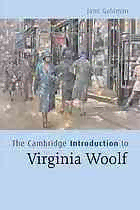Table Of ContentThis page intentionally left blank
The CambridgeIntroduction to
Virginia Woolf
Forstudents of modern literature, theworksof VirginiaWoolf are
essentialreading. In her novels, short stories,essays,polemical
pamphlets and in herprivate letters she explored,questioned and
refashionedeverythingaboutmodernlife:cinema,sexuality,shopping,
education, feminism, politicsand war. Herelegant andstartlingly
originalsentencesbecameamodelofmodernist prose.This is a clear
and informativeintroduction toWoolf’slife,works,andculturaland
criticalcontexts,explainingtheimportanceoftheBloomsburygroupin
the development ofher work.Itcovers themajor worksin detail,
including Tothe Lighthouse, Mrs Dalloway, The Waves andthe key
shortstories. As well as providing studentswith the essential
information needed to study Woolf, JaneGoldmansuggestsfurther
reading toallowstudentsto find their way throughthe most
important criticalworks.All students ofWoolf will find this a useful
and illuminating overviewof the field.
JANEGOLDMANisSenior Lecturerin English and American Literatureat
the Universityof Dundee.
Cambridge Introductions to Literature
This series is designed to introduce students to key topics and authors.
Accessible and lively, these introductions will also appeal to readers who
wanttobroadentheirunderstandingofthebooksandauthorstheyenjoy.
(cid:1) Idealforstudents,teachers,andlecturers
(cid:1) Concise,yetpackedwithessentialinformation
(cid:1) Keysuggestionsforfurtherreading
Titles in this series:
BulsonTheCambridgeIntroductiontoJamesJoyce
CooperTheCambridgeIntroductiontoT.S.Eliot
DillonTheCambridgeIntroductiontoEarlyEnglishTheatre
GoldmanTheCambridgeIntroductiontoVirginiaWoolf
HoldemanTheCambridgeIntroductiontoW.B.Yeats
McDonaldTheCambridgeIntroductiontoSamuelBeckett
PetersTheCambridgeIntroductiontoJosephConrad
ScofieldTheCambridgeIntroductiontotheAmericanShortStory
ThomsonTheCambridgeIntroductiontoEnglishTheatre,1600–1900
ToddTheCambridgeIntroductiontoJaneAusten
The Cambridge Introduction to
Virginia Woolf
JANE GOLDMAN
CAMBRIDGE UNIVERSITY PRESS
Cambridge, New York, Melbourne, Madrid, Cape Town, Singapore, São Paulo
Cambridge University Press
The Edinburgh Building, Cambridge CB2 8RU, UK
Published in the United States of America by Cambridge University Press, New York
www.cambridge.org
Information on this title: www.cambridge.org/9780521838832
© Jane Goldman 2006
This publication is in copyright. Subject to statutory exception and to the
provision of relevant collective licensing agreements, no reproduction of any part
may take place without the written permission of Cambridge University Press.
First published in print format 2006
ISBN-13 978-0-511-56716-2 eBook (Dawsonera)
ISBN-13 978-0-521-83883-2 hardback
ISBN-13 978-0-521-54756-7 paperback
Cambridge University Press has no responsibility for the persistence or accuracy
of urls for external or third-party internet websites referred to in this publication,
and does not guarantee that any content on such websites is, or will remain,
accurate or appropriate.
Contents
Preface page vii
List of abbreviations x
Chapter 1 Life 1
1882–1909 3
The 1910s 11
The 1920s 17
1930–1941 21
Chapter 2 Contexts 25
Biographies 27
Bloomsbur y 32
Wider historical and political contexts 33
Modern and contemporar y cultural contexts 34
Chapter 3 Works 37
Woolf ’s fiction 38
Woolf ’s nonfiction 96
Other essays 112
Chapter 4 Critical reception 123
Introductor y reading 125
Critical reception 127
Contemporar y rev iews and the 1940s:
innovation, experimentalism, impressionism 127
vi Contents
The 1950s and 1960s: philosophy,
psycholog y, myth 129
The 1970s and 1980s: feminism, androg yny,
modernism, aesthetics 130
The 1980s: feminism, postmodernism,
sexual/textual politics 132
The 1990s to the present: feminism,
historicism, postcolonialism, ethics 134
Notes 137
Guide to further reading 140
Index 145
Preface
ReadingVirginiaWoolfwillchangeyourlife,mayevensaveit.Ifyouwantto
make sense of modern life, the works of Virginia Woolf remain essential
reading.Morethanfiftyyearssinceherdeath,accountsofherlifestillsetthe
paceformodernmodesofliving.Plunge(andthisIntroductionisintendedto
helpyoutaketheplunge)intoWoolf’sworks–atanypoint–whetherinher
novels, her short stories, her essays, her polemical pamphlets, or her pub-
lishedletters,diaries,memoirsandjournals–andyouwillbetransportedby
her elegant, startling, buoyant sentences to a world where everything in
modern life (cinema, sexuality, shopping, education, feminism, politics,
war and so on) is explored and questioned and refashioned. ‘My brain’, she
confides in one diary entry, ‘is ferociously active’ (D3 132); and Woolf’s
writing is infused with her formidably productive mental energy, with her
appetite for modern life, modern people and modern art. Woolf’s writing
both records and shapes modern experience, modern consciousness; but it
also opens up to scrutiny the process of writing itself, a process she herself
frequently records, and also finds exhilarating.
Shefamouslydepictsfictionalwriting,inARoomofOne’sOwn(1929),as
‘aspider’sweb,attachedeversolightlyperhaps,butstillattachedtolifeatall
four corners’. Fictional works may, Woolf claims, ‘seem to hang there com-
pletebythemselves.Butwhenthewebispulledaskew,hookedupattheedge,
torn in the middle, one remembers that these webs are not spun in mid-air
byincorporealcreatures,butaretheworkofsuVeringhumanbeings,andare
attachedtogrosslymaterialthings,likehealthandmoneyandthehouseswe
live in’ (AROO 62–3). This Introduction will guide you through Woolf’s
writing, but also delineate for you the life of the person who produced it
(hercriticalandculturalafterlife,too):youwillbeintroduced,then,toboth
spider and web. As an appetiser to both, let us sample Woolf’s fascinating
account of her writing process at the heart of her writing life.
In the spring of 1927, the 35-year-old Woolf takes stock, in one brief
diary entry, of her achievements to date – she has by now published five
novels,includingMrsDalloway(1925)andTotheLighthouse(1927)–asshe
vii
viii Preface
contemplates beginning her sixth novel, Orlando (1928), and even enjoys
glimpses of her seventh, The Waves (1931); at the same time, she is also
knucklingdowntowritingthemostenduringlymodern,feministmanifesto,
A Room of One’s Own. Considering the shape of the work that is to become
Orlando,sheenvisagesthat‘Everythingistobetumbledinpallmall[sic].Itis
tobewrittenasIwritelettersatthetopofmyspeed...Noattemptistobe
madetorealisethecharacter.Sapphismistobesuggested.Satireistobethe
mainnote–satire&wildness’(D3131).Butthisnovelisalsoto‘satirise’her
own, previous writing:
ForthetruthisIfeeltheneedofanescapadeafter theseseriouspoetic
experimental books . . . Iwant tokick upmyheels & be oV. Iwant to
embodyallthoseinnumerablelittleideas&tinystorieswhichflashinto
my mind at all seasons. Ithink this willbe greatfun towrite; &it will
restmyhead beforestarting thevery serious,mysticalpoeticalwork
whichIwant tocomenext. (D3 131)
This premonition of the novel that becomes The Waves sets her thinking
about her writing agenda for the coming months, and her own creative
processes:
Meanwhile ...Ihavetowrite mybookonfiction [A Room of One’s
Own]& that wontbe done till January, Isuppose. Imightdash oV a
pageor twonow& then bywayofexperiment. And itis possible that
the ideawillevaporate. Anyhow this records theoddhurried
unexpectedwayinwhichthesethingssuddenlycreatethemselves–one
thingon top of anotherin about an hour. So ImadeupJacob’sRoom
lookingatthefireatHogarthHouse;soImadeupTheLighthouseone
afternoon in the squarehere. (D3 131–2)
However quickly he r works are conceived and ‘made up’, as she records
here,Woolf’sfinalpublishedworksweknowtohavebeenrigorouslydrafted
andredrafted.Everywordineverysentenceoneverypagehasbeensubjected
to her scrutiny. Her pride in such perfectionism is evident in another diary
entry:‘Dearme,howlovelysomepartsofTheLighthouseare!Soft&pliable,
& I think deep, & never a word wrong for a page at a time’ (D3 132). The
following Introduction to Woolf aims to show you the main features of her
web,butalsotoilluminatesomeofitsfinelywroughtdetail,too–thecrucial
engineering of her sentences, the devastating precision of her words. It will
alsoconsiderhowbothspiderandwebhaveinturnbeenwovenintodecades
of literary criticism and theory, and academic and popular accounts of
modernculture.Inshort,TheCambridgeIntroductiontoVirginiaWoolfoVers

